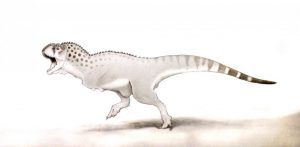
One of the last dinosaurs living in Africa before their extinction 66 million years ago has been discovered in a phosphate mine in northern Morocco. A study of the fossil, led by the Milner Centre for Evolution at the University of Bath, suggests that following the breakup of the supercontinent Gondwana in the middle of the Cretaceous period, a distinct dinosaur fauna evolved in Africa.
- The new species, Chenanisaurus barbaricus, was of one of the last dinosaurs on Earth and among those species wiped out when an asteroid hit 66 million years ago
- It is the smaller African contemporary of the North American T. rex
- Fossil is evidence of distinct fauna in southern hemisphere at this time
Almost nothing is known about the dinosaurs that lived in Africa at the end of the Cretaceous period 66 million years ago, just before they were wiped out by the impact of a giant asteroid. At this time sea levels were high, and so most of the fossils come from marine rocks.
Among these are the phosphate deposits of Morocco — remains of an ancient seabed, laid down 66 million years ago. The phosphate is harvested from vast strip mines and is used in everything from fertilizer to cola drinks.
Last year, Dr Nick Longrich, from the Milner Centre for Evolution and the Department of Biology & Biochemistry at the University of Bath, studied a rare fragment of a jaw bone that was discovered in the mines at Sidi Chennane in the Oulad Abdoun Basin, Morocco. In collaboration with colleagues based in Morocco, France, and Spain, Longrich identified it as belonging to an abelisaur.
Abelisaurs were two-legged predators like T. rex and other tyrannosaurs, but with a shorter, blunter snout, and even tinier arms. While the tyrannosaurs dominated in North America and Asia, the abelisaurs were the top predators at the end of the Cretaceous in Africa, South America, India, and Europe.
Dr Longrich explained: “This find was unusual because it’s a dinosaur from marine rocks — it’s a bit like hunting for fossil whales, and finding a fossil lion. It’s an incredibly rare find — almost like winning the lottery. But the phosphate mines are so rich, it’s like buying a million lottery tickets, so we actually have a chance to find rare dinosaurs like this one.”
“We have virtually no dinosaur fossils from this time period in Morocco — it may even be the first dinosaur named from the end-Cretaceous in Africa. It’s also one of the last dinosaurs in Africa before the mass extinction that wiped out the dinosaurs.
“It’s an exciting find because it shows just how different the fauna was in the Southern hemisphere at this time.”
Named Chenanisaurus barbaricus, the newly discovered dinosaur stood on two legs and had stumpy arms. Dr Longrich added: “Abelisaurs had very short arms. The upper arm bone is short, the lower arm is shorter, and they have tiny little hands.”
The teeth from the fossil were worn as if from biting into bone, suggesting that like T. rex, Chenanisaurus was a predator. However, unlike the partially feathered T. rex, Chenanisaurus had only scales, its brain was smaller, and its face was shorter and deeper.
The research project was carried out as part of an international scientific collaboration that is helping create and study paleontology collections in Morocco with the aim of conserving the country’s rich fossil heritage. The specimens used for this study are conserved in the Office Chérifien de Phosphates paleontological collection in Morocco.
Reference:
Nicholas R. Longrich, Xabier Pereda-Suberbiola, Nour-Eddine Jalil, Fatima Khaldoune, Essaid Jourani. An abelisaurid from the latest Cretaceous (late Maastrichtian) of Morocco, North Africa. Cretaceous Research, 2017; 76: 40 DOI: 10.1016/j.cretres.2017.03.021
Note: The above post is reprinted from materials provided by University of Bath.










